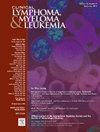Comparison of Long-Term Outcomes of Double Unit Cord Blood Versus Haploidentical Donor Transplantation in Adult Patients With Acute Lymphoblastic Leukemia Regarding KIR-Ligand Mismatch
IF 2.7
4区 医学
Q2 HEMATOLOGY
引用次数: 0
Abstract
Background
Haploidentical donor transplantation (HIDT) or cord blood transplantation (CBT) are common alternatives for patients lacking human-leukocyte antigen (HLA)-matched donors. In addition to the donor source, NK cell alloreactivity due to HLA-mismatch setting may affect outcomes in alternative-donor hematopoietic cell transplantation (HCT). However, a limited number of studies have evaluated their impacts in adult acute lymphoblastic leukemia (ALL).
Objectives
We aimed to assess the effects of donor source and KIRL-MM on outcomes of alternative-donor HCT, with a special focus on adult ALL.
Study Design
We retrospectively compared clinical outcomes between HIDT (n=47) and double unit CBT (DCBT) (n=134). Patients received fludarabine and busulfan-based reduced toxicity conditioning before HIDT, and TBI-based myeloablative conditioning before DCBT. KIR ligands were determined using a web-based calculator. For DCBT, donor KIR ligand groups were defined by the dominant CB unit after engraftment.
Results
After a median follow-up of 39.4 months, DCBT showed higher 3-year non-relapse mortality (NRM) (22.8% vs. 9.0%, p=0.038), whereas the cumulative incidence of relapse (CIR) was significantly higher in HIDT (47.9% vs. 18.9%, p<0.001). Estimated disease-free survival (DFS) was comparable (DCBT 58.5% vs. HIDT 44.3%, p=0.106). GVH direction KIRL-MM showed lower incidence of acute GVHD in both HIDT and DCBT. However, GVH direction KIRL-MM was associated with poorer DFS (37.2% vs. 66.0%, p=0.008) only in the DCBT subgroup, mostly due to specifically higher NRM rate (35.0% vs 18.4%, p=0.057).
Conclusion
Our study supports the usefulness of DCBT in the HIDT-dominant era and suggests potential ways to improve survival outcomes of DCBT.
双单位脐带血与单倍体供体移植治疗成人急性淋巴细胞白血病的长期疗效比较
背景:单倍体供体移植(HIDT)或脐带血移植(CBT)是缺乏人类白细胞抗原(HLA)匹配供体的患者的常见选择。除了供体来源外,由于hla错配设置导致的NK细胞异体反应性也可能影响替代供体造血细胞移植(HCT)的结果。然而,有限数量的研究评估了它们对成人急性淋巴细胞白血病(ALL)的影响。目的:我们旨在评估供体来源和KIRL-MM对替代供体HCT结果的影响,特别关注成人ALL。研究设计:我们回顾性比较了HIDT (n=47)和双单位CBT (n=134)的临床结果。患者在HIDT前接受以氟达拉滨和布硫凡为基础的降低毒性调节,在DCBT前接受以tbi为基础的清髓调节。使用基于网络的计算器确定KIR配体。对于DCBT,供体KIR配体基团由植入后的优势CB单位定义。结果:中位随访39.4个月后,DCBT显示出更高的3年非复发死亡率(NRM) (22.8% vs. 9.0%, p=0.038),而HIDT的累积复发发生率(CIR)显著更高(47.9% vs. 18.9%)。结论:我们的研究支持DCBT在HIDT占主导地位的时代的有效性,并提出了改善DCBT生存结果的潜在方法。
本文章由计算机程序翻译,如有差异,请以英文原文为准。
求助全文
约1分钟内获得全文
求助全文
来源期刊

Clinical Lymphoma, Myeloma & Leukemia
ONCOLOGY-HEMATOLOGY
CiteScore
2.70
自引率
3.70%
发文量
1606
审稿时长
26 days
期刊介绍:
Clinical Lymphoma, Myeloma & Leukemia is a peer-reviewed monthly journal that publishes original articles describing various aspects of clinical and translational research of lymphoma, myeloma and leukemia. Clinical Lymphoma, Myeloma & Leukemia is devoted to articles on detection, diagnosis, prevention, and treatment of lymphoma, myeloma, leukemia and related disorders including macroglobulinemia, amyloidosis, and plasma-cell dyscrasias. The main emphasis is on recent scientific developments in all areas related to lymphoma, myeloma and leukemia. Specific areas of interest include clinical research and mechanistic approaches; drug sensitivity and resistance; gene and antisense therapy; pathology, markers, and prognostic indicators; chemoprevention strategies; multimodality therapy; and integration of various approaches.
 求助内容:
求助内容: 应助结果提醒方式:
应助结果提醒方式:


